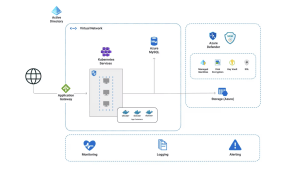As software becomes ever-present, from mobile apps to cloud infrastructures, vulnerabilities within code have become prime targets for cybercriminals. For developers, understanding and implementing code security is no longer optional—it’s a fundamental responsibility that can make or break a company’s reputation and bottom line.
This comprehensive guide delves into the world of code security, offering insights and best practices that every developer should know. From the basics of secure coding to advanced DevOps security integration, we’ll explore how to build robust, resilient software that can withstand the ever-evolving landscape of cyber threats.
Code Security: More Than Just a Buzzword
Code security, at its core, is about writing software resistant to attacks and vulnerabilities. According to Check Point Software, it encompasses a range of practices designed to protect applications from threats throughout their lifecycle—from development to deployment and beyond.
But why is it so crucial? Consider this: a single security breach can cost a company millions of dollars, erode customer trust, and potentially lead to legal repercussions. In 2023 alone, the average data breach cost reached $4.45 million, according to IBM’s Cost of a Data Breach Report. This staggering figure underscores the financial imperative of prioritizing code security.
The Pillars of Secure Coding
Secure coding is not just about writing complex algorithms or implementing the latest security features. It’s a mindset that should permeate every aspect of the development process. The University of California, Berkeley outlines several vital principles that form the foundation of secure coding practices:
- Input Validation: Never trust user input. Validate and sanitize all data entering your application to prevent injection attacks and other malicious inputs.
- Authentication and Authorization: Implement robust systems to verify user identities and control resource access.
- Secure Data Storage and Transmission: Encrypt sensitive data at rest and in transit to protect against unauthorized access.
- Error Handling and Logging: Implement proper error handling to prevent information leakage and maintain detailed logs for auditing and incident response.
- Least Privilege Principle: Grant users and processes only the minimum level of access necessary to perform their functions.
These principles are not just theoretical concepts—they’re practical guidelines that can significantly reduce the attack surface of your applications. By internalizing these practices, developers can create a solid foundation for secure software development.
DevOps and Security: A Crucial Partnership
In today’s fast-paced development environments, integrating security into DevOps processes—often called DevSecOps—is becoming increasingly important. This approach aims to bake security into every stage of the software development lifecycle, from initial design to deployment and maintenance.
Legit Security provides a step-by-step guide for integrating security into DevOps, emphasizing the importance of:
- Automating security checks within CI/CD pipelines
- Conducting regular security training for development teams
- Implementing security as code practices
- Establishing clear security policies and guidelines
By adopting these practices, organizations can significantly reduce the time and cost of addressing security issues late in the development cycle. Moreover, it fosters a culture of security awareness among developers, making them active participants in the security process rather than viewing it as a bottleneck.
Measuring Success: DevOps Security KPIs
To ensure that security initiatives are effective, it’s crucial to establish and monitor key performance indicators (KPIs). DuploCloud suggests several essential DevOps KPIs that can be adapted for security purposes:
- Mean Time to Detect (MTTD): How quickly can security issues be identified?
- Mean Time to Resolve (MTTR): How long does addressing and fixing security vulnerabilities take?
- Deployment Frequency: How often are secure updates and patches deployed?
- Change Failure Rate: What percentage of changes result in security incidents?
By tracking these metrics, development teams can gain valuable insights into their security practices’ effectiveness and identify areas for improvement.
Tools of the Trade: Empowering Developers with Security Analysis
Developers are not alone in the quest for code security. A plethora of tools exist to assist in identifying and mitigating security vulnerabilities. The InfoSec Institute highlights several top code analysis tools that can be integrated into the development workflow:
- Static Application Security Testing (SAST) tools: These analyze source code to identify potential security flaws before compilation.
- Dynamic Application Security Testing (DAST) tools: These test running applications to find vulnerabilities that may only appear during execution.
- Software Composition Analysis (SCA) tools: These scan and analyze open-source components for known vulnerabilities.
While these tools are invaluable, it’s important to remember that they are aids, not replacements for developer knowledge and judgment. The most effective security strategies combine automated tools, human expertise, and critical thinking.
Best Practices for Secure Development
Implementing code security is an ongoing process that requires vigilance and commitment. GuardRails offers a comprehensive guide to secure coding practices, which includes:
- Regular Code Reviews: Implement peer reviews to catch security issues early in development.
- Continuous Learning: Stay updated on the latest security threats and mitigation techniques.
- Secure API Design: Implement proper authentication, rate limiting, and input validation for all APIs.
- Third-Party Component Management: Regularly update and audit third-party libraries and frameworks for known vulnerabilities.
- Secure Configuration Management: Ensure that all environments, from development to production, are securely configured.
When consistently applied, these practices can significantly enhance any software project’s security posture.
The Future of Code Security: Embracing AI and Machine Learning
As we look to the future, artificial intelligence and machine learning are poised to play an increasingly significant role in code security. These technologies offer the potential for more sophisticated threat detection, automated vulnerability remediation, and even predictive security measures that can anticipate and prevent attacks before they occur.
However, with these advancements come new challenges. As AI becomes more integrated into security tools, developers will need to understand how to use these tools and their limitations and potential biases. The ethical implications of AI in security, such as privacy concerns and the potential for automated decision-making in critical systems, must also be carefully considered.
Security as a Shared Responsibility
In the digital age, code security is not just the responsibility of a dedicated security team—it’s a shared obligation that extends to every developer, manager, and stakeholder involved in the software development process. By embracing secure coding practices, integrating security into DevOps processes, and leveraging cutting-edge tools and technologies, developers can create software that is functional, efficient, and resilient against the myriad of threats in today’s digital landscape.
As we continue to push the boundaries of what’s possible with software, let us remember that with great power comes great responsibility. The code we write today will shape the digital world of tomorrow. By prioritizing security, we’re not just protecting our applications—we’re safeguarding the trust, privacy, and well-being of the millions of users who rely on our software daily.
In the words of Bruce Schneier, a renowned security technologist, “Security is not a product, but a process.” It’s a journey of continuous improvement, learning, and adaptation. As developers, we are on the front lines of this journey, armed with the knowledge, tools, and practices to build a more secure digital future. Let’s embrace this challenge with the creativity, diligence, and passion that defines our craft.
You may also be interested in Time to Market: The Complete Guide for High-Growth Companies
Eliminate DevOps hiring needs. Deploy secure, compliant infrastructure in days, not months. Accelerate your launch and growth by avoiding tedious infrastructure tasks. Join thousands of Dev teams getting their time back. Leverage DuploCloud DevOps Automation Platform, backed by infrastructure experts, to automate and manage DevOps tasks. Drive savings and faster time-to-market with a 30-minute live demo
.



